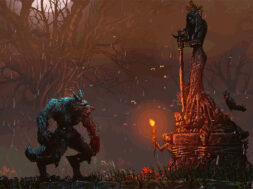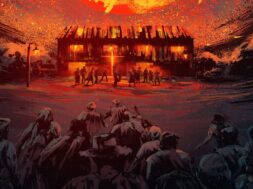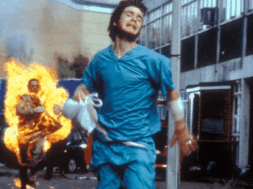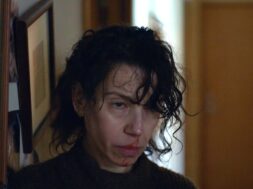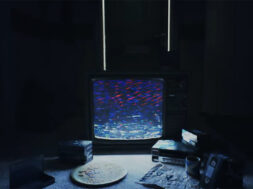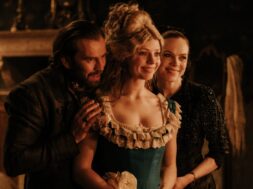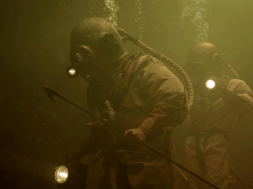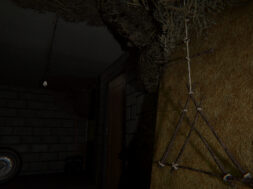The Spider and the Butterfly: ‘The Innocents’ and the Original Haunting of Bly Manor [Gods and Monsters]
In Bride of Frankenstein, Dr. Pretorius, played by the inimitable Ernest Thesiger, raises his glass and proposes a toast to Colin Clive’s Henry Frankenstein—“to a new world of Gods and Monsters.” I invite you to join me in exploring this world, focusing on American horror films from the dawn of the Universal Monster movies in 1931 to the collapse of the studio system and the rise of the new Hollywood rebels in the late 1960s. With this period as our focus, and occasional ventures around the world and to earlier and later times, we will explore this magnificent world of classic horror.
2020 was bookended by updated adaptations of the classic Henry James ghost story “The Turn of the Screw.” The Turning, released in January, was not particularly well received by critics or audiences, while Mike Flanagan’s recent The Haunting of Bly Manor series for Netflix was widely praised, embraced by audiences, and a massive hit for the streaming juggernaut. James’s story has been the subject of several adaptations over the years, with mixed results, but the first film adaptation of the story remains a masterpiece of subtle, atmospheric horror—The Innocents.
Ghost stories and haunted house films up to that point had primarily been humorous tales. The Cat and the Canary (1927 and 1939), The Old Dark House (1932), the William Castle films The House on Haunted Hill (1959) and 13 Ghosts (1960) are all prime examples. Director Jack Clayton sought to make a very different kind of film with much more serious, adult themes and sensibilities; something more in the tradition of Val Lewton’s understated and suggestive horrors for RKO than the more overt heritage of Universal and Hammer films.
The Innocents (1961) is a film about secrets and what it means to be innocent—or good and bad as the children say often throughout the film. It is filled with mystery, discovery, and above all, ambiguity. The film follows the main beats of the Henry James story while also drawing upon other sources including a stage adaptation by William Archibald (who shares screenplay credit), and an opera by the great twentieth century British composer Benjamin Britten. But perhaps most responsible for the film’s mood and power, at least behind the camera, are Clayton, director of photography Freddie Francis, and writer Truman Capote. The three had worked together previously on the John Huston film Beat the Devil (1953) starring Humphrey Bogart, a decidedly different film from The Innocents, but also a classic made with impeccable skill.
20th Century Fox owned the rights to William Archibald’s play, The Innocents, and Jack Clayton worked with him to fashion the script into a workable screenplay. Their collaboration resulted in the basic structure as well as several important elements of the final film, but Clayton was not entirely satisfied. He reached out to several writers including Harold Pinter and John Mortimer, both of whom offered key elements, scenes, and dialogue. But the writer who really locked into what Clayton was looking for was Truman Capote, whom Clayton later credited for ninety percent of the film’s ideas. Much of the subtext, nature metaphor, and the sense of sprawling decay found in the film is due to Capote’s connection to the Southern Gothic style made popular by writers like William Faulkner, Eudora Welty, Flannery O’Connor, and of course Capote’s dear friend Harper Lee. That sensibility is infused into the very marrow of this film.
The gardens, the statuary, the buzzing of insects, the facades crumbling under encroaching nature all have something of this American South feel to them, but never take the audience out of its English, mid-Victorian setting. Early on he introduces an image that becomes the central metaphor of the film. Flora—the “child of the flowers” (played by Pamela Franklin)—observes “a lovely spider and it’s eating a butterfly,” just after we learn that her brother Miles will be returning home from school. This somewhat disturbing, though natural, image becomes the key to the film, but it also continually challenges our assumptions by forcing us to question who is the spider and who is the butterfly.
From the very beginning, it is clear that The Innocents will be a very different kind of horror film. It starts with a black screen and a haunting folk melody, “O Willow Waly,” being sung by a child, who we soon learn is little Flora, her connection to nature—and perhaps the supernatural—evident in the lyrics to this song. Even as the 20th Century Fox logo appears in its full cinemascope glory, there is no familiar fanfare, only this melancholy tune. Out of the darkness, hands pressed together as if in prayer rise into the frame and we hear a woman’s voice weeping and earnestly saying, “all I want to do is save the children, not destroy them.” Words that turn out to be as melancholy as the recurring tune that haunts the film like the spirits of Bly.
The film constantly urges us to peel back the layers, to look beyond the shiny surfaces to the fragility that lies beneath. The house is filled with white roses that drop their petals at the slightest touch. A beetle crawls from the mouth of a statue of a child. There is a sense that the whole of Bly Manor and its grounds are crumbling and decaying. Still, the film rarely gives way to traditional trappings of gothic horror. Only two key scenes are filled with cobwebs and dust. One is the moment after Deborah Kerr, in quite possibly the best performance of her career, as the governess Miss Giddens sees a man standing at the battlements of Bly’s tower. She climbs a cobwebbed staircase, reminiscent of the bell tower stairs in Alfred Hitchcock’s Vertigo, to find Miles (Martin Stephens, who played another creepy child in Village of the Damned, 1960) tending to white pigeons that have roosted on the tower roof. While climbing the stairs we feel that Miss Giddens, surrounded by all those webs, may be the butterfly being drawn into a trap set by Miles and the mysterious man. Later, during a game of hide and seek, she climbs to the unkempt attic where she discovers a cracked picture of a man and a ballerina music box that plays Flora’s tune. Moments later, as she hides behind a curtain, Miss Giddins sees the man from the photograph float to the window beside her. We soon discover that he is Peter Quint (Peter Wyngarde), the deceased valet to the children’s uncle, briefly, but memorably, played by Michael Redgrave in the opening scene.
Gradually, Miss Giddens, the sheltered daughter of a fundamentalist vicar, begins to suspect that Miles is possessed by Quint, and Flora by his also deceased lover, her predecessor as governess, Miss Jessel. This brings in a new layer of theme dealing with sexual repression and religious zealotry. Miss Giddins tells Miles that she was raised to help people, to “help them even if they refuse my help” in a frightening reference to forced religious conversion. She goes about attempting to save the children by getting them to confess that they are possessed.
In this element, I see a theme not often discussed in relation to this film that seems to be an intentional subtext from Capote. The Red Scare was in full force in the early 1960s and the Hollywood blacklist era had only recently come to an end with the release of Spartacus (1960). Miss Giddins is paranoid by the secrets of Bly, that are only reluctantly revealed to her by Mrs. Grose (Megs Jenkins). She is convinced the secrets that Miles and Flora whisper in each other’s ears mean they are up to some kind of mischief, partially because they refuse to tell. Miles never reveals specifically why he was expelled from school. She takes this all to mean they are hiding something evil and believes that by confessing, either willingly or by force, they will be freed. This is much like the mentality of Senator Joseph McCarthy and his ilk in the 1950s Senate hearings that blacklisted the Hollywood Ten, a group of writers who refused to name names of people suspected of membership in the Communist party, resulting in the ruination of many careers and reputations. The repercussions were still being felt by the time of this film’s production.
This subtext and others only reveal how malleable the plot and themes of Henry James’s story are. In Victorian times it was about class distinctions, gender roles, and repression. Later, the film The Nightcomers (1971), a sort of prequel to the story, dealt with sexual politics. The Turning is largely about toxic masculinity and mental illness. In all cases, subjects at the forefront of concern for their time. In The Innocents, all of these themes are included in some form or another, but they are paired with an overarching ambiguity that is very present in the original story. We never know for sure whether anyone but Miss Giddens sees the ghosts of Peter Quint and Miss Jessel. All the other characters deny seeing anything. But then, they could be lying. The film works completely both as a traditional—external—ghost story and as a psychological—internal—drama.
By the end, the film is filled with strange, and sometimes uncomfortable sexual tension. As already discussed, Miss Giddens believes that Miles is possessed by Peter Quint and therefore assumes that Flora must be possessed by the spirit of Miss Jessel. She seems to have no awareness of the fact that it is she herself who is very much falling into Miss Jessel’s role. She begins to dress all in black as her predecessor did. She allows Miles to be cruel to her but refuses to give up on him. In the closing scene we wonder once again who has been the spider and who has been the butterfly. Nothing may be as it seems, but the film leaves all of this up to us to decide. Its ambiguity is its greatest strength and why the film endures.
Since The Innocents, many ghost stories have followed in its subtle and ambiguous footsteps. The Haunting (1963), The Changeling (1980), and The Others (2001) are some of the best. Still, there is something specifically enduring about the story and setting of Bly Manor. This version of that story is so layered, so dense, and so thematically and psychologically rich that it stands among the greatest horror films ever made. It could, and likely will, be endlessly discussed. It is a masterpiece that has endured because of these qualities and more. It is a perfect companion to the very different version of the story produced by Mike Flanagan and feels very modern despite its nineteenth century setting and mid-twentieth century production. I had seen the film once or twice before but found far greater appreciation for it than ever upon a rereading of “The Turn of the Screw” and when watched in tandem with The Haunting of Bly Manor.
Film historian Sir Christopher Frayling calls The Innocents “the greatest ghost story ever filmed based on the greatest ghost story ever written.” I find it difficult to disagree.
